RENEGADE GARDENER™
The lone voice of horticultural reason
Project #2: Dream Job
8-8-05 – Two words that always turn my head: “New construction.”
Two more words that put youth in my step: “Full sun.”
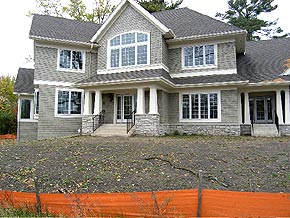 |
| Project #2, a big, beautiful, blank slate. |
Nothing is dearer to a crusty, cynical, and sore-backed old landscaper’s heart than a job involving a brand-new house sitting in sunshine on bare dirt. You get out of your pickup truck and gaze out over an empty canvas, a clean slate, one of those wild and wonderful landscaping opportunities where you don’t have to deal with a previous landscaper’s insipid design, or a previous homeowner’s misguided attempts at yard beautification.
Best of all, most of the trees you would have argued for cutting down have already been dispatched by the builder.
Another nice thing about new homes is that quite often you have a decent budget to work with, as more and more couples who build new homes actually have the sense to include ample money for landscaping in their overall construction budget.
As was the case here, where I’m dealing with a 1.25 million dollar house set nicely on a rolling, wooded, one-acre lot in the far western suburbs of Minneapolis. The homeowners wanted landscaping that wasn’t ordinary, something that would show off their beautiful house but not dominate it. They wanted a grand stone walkway leading up the front, and a big patio down the hill on one end, with a fire pit …
We better get to work:
Landscape plans are for beginners. Landscapers charge homeowners two to five thousand dollars in design fees for a project of this scope because (a) there’s profit in design, and (b) the designer doesn’t go near the installation.
I met with the homeowners and did more talking than drawing, laying out a rough idea for the walkway with garden hoses and listing and describing the plants I would use in the foundation beds that the walkway naturally defined. Then we jumped right into installing the walkway, as follows:
I began by looking at the area until my eye saw the best river—that’s what I was looking for, the gentle, curving river that naturally ran from the front door down a slight hill to the driveway. When you look for the river, don’t give it too many bends; less is always more.
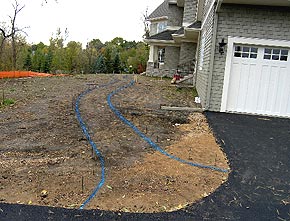 |
| Blue spray paint is sprayed along edge of hoses, then the hoses removed. Note the green bamboo stakes along each edge that allow for visualization of walkway at a five-foot width. |
The walkway measured 86 feet from driveway to front door, with two walkways branching off one side, one a narrow utility path from garage to main walk, and a second branch that leads to the secondary entrance to the home. “The maid’s entrance,” I called it, and the young homeowners would smile a little but look squeamish.
I originally proposed a width of four feet for the walkway, but told the homeowner that we might discover that five feet is needed. Sure enough, when I painted the walkway in at four feet wide—plenty wide for most sidewalks leading to a home—it looked skimpy. I’ve always considered a four-foot width as the minimum for any grand entrance to a large home, but due to the relatively great length involved here, four feet immediately looked too narrow. If the walkway had been only 20 or 30 feet, four feet would have looked fine. When you’re running over 80 feet, however, my eye told me we needed to go wider, and fortunately the homeowner agreed and approved. It’s a scale thing.
 |
 |
| Walkway view from front door down to driveway. | View of branch walk leading to secondary entrance. |
After layout was complete, I excavated the area to a depth of nine inches. Nine inches figures for five inches of compacted Class V gravel base, one inch of sand, and three-inch (average) width of the stone. I chose to use patterned New York bluestone (with the homeowners’ immediate blessing). It’s durable, classy, and timeless, and in this quantity and to this level of precision installation, you can price it to the moon.
Probably no sense wasting time with much more discussion of the preparation, let’s jump right to the “After.”
 |
 |
| Class V gravel base after compacting. | Nothing in a landscape of this type works unless you get the river right. |
An inch of sand was smoothed over the Class V gravel, then the fun began. Renegade foreperson Judy and I started at the top with an eye for the bottom, using stone hooks and setting each stone by hand. I had carefully graded the base so that the sidewalk tilts to the lawn side at a rate of one-half inch per five feet, for drainage. We set the sidewalk so edge pieces always extended out wider than five feet. When finished, I used 16’ lengths of flexible aluminum edging to redefine the curving edges, traced the curves with a Sharpie, and cut the curves in using a cut-off saw with diamond blade.
As to the rest of the project, I’ll let the pictures tell the story. They were shot at different times during the project, so you’ll notice that in some of the photos the final perennials have not been planted:
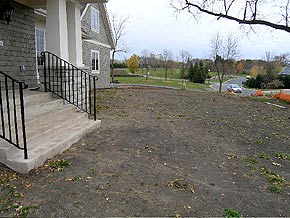 |
 |
| Before … | … and after. |
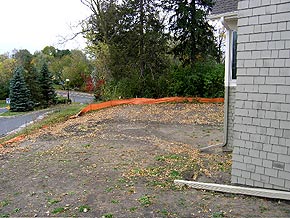 |
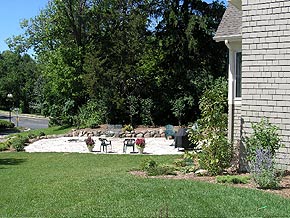 |
| Can you see the … |
… patio? |
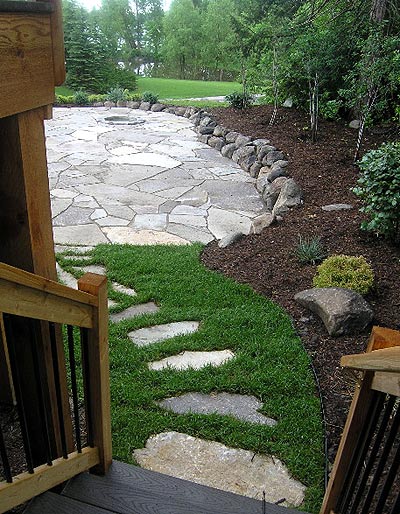 |
Deck entrance to patio. |
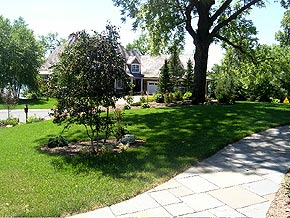 |
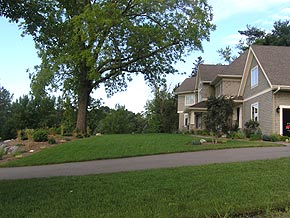 |
| The island tree bed (featuring Betula szechuanica ‘Royal Frost’) was essential to give visual height and weight to the entrance to the walkway, countering the beds between walkway and garage. | Same principle here. The homeowner wanted lawn to run from walkway (right) all the way to the boulder retaining wall (left). I lobbied that the far side of the yard needed landscaping—not grass—in the form of a long bed … |
 |
 |
| … flowing from the large basswood tree toward the driveway … | … and curling around the boulder wall to encompass the mailbox and drive entrance. I won. |
By the way, you should see the other expensive, iron or cast aluminum mailboxes sitting along the street in front of the other million-dollar homes. Most sit at the edge of the driveway in plain grass. An unfortunate few are circled with Stella de Oro daylilies (don’t get me started …). Here, annuals provide a splash of color and announce the entrance.
I also instructed the builder to set the mailbox six feet away from the driveway. Every other mailbox in the development is set at “2 x 2”—two feet from the street, two feet from the drive. You have no space to landscape without the mailbox sitting like a sore thumb in a corner. Also, when a mailbox is that tight, the wife would not have been able to stop for the mail, then turn sharply left into the driveway without eventually scraping her mini-van on a $1,050.00 mailbox. She would have had to back up, then turn out onto the street and THEN left into the driveway. Now she gets the mail, pulls forward, then turns left without trampling the landscaping. You have to think about these things.
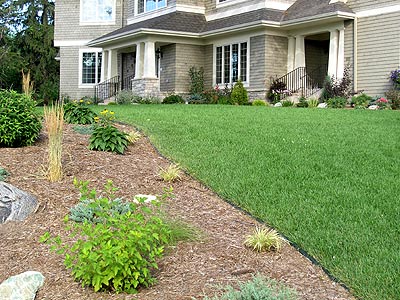 |
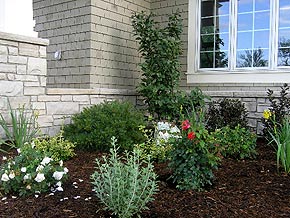 |
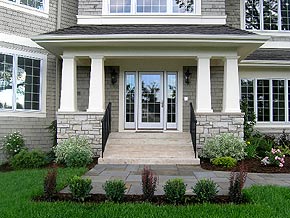 |
| I couldn’t resist a formal affront, the only formal touch to the entire landscape. | |
 |
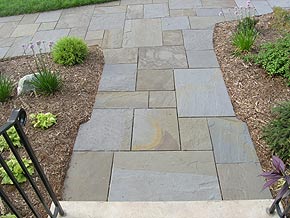 |
| Narrow utility walkway to garage. It’s just like cutting wood, only a tenth as fast and with a really expensive blade. | Maid’s entrance. |
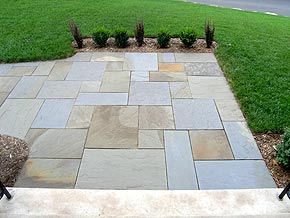 |
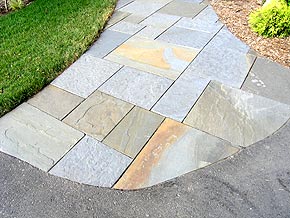 |
| Boxwood and barberry ‘Helmond Pillar’ will fill out to create a low, formal fence to keep feet (and the eye) from lurching off the front entrance landing. | Patterned New York bluestone. Measure twice… |
 |
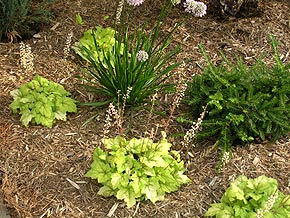 |
| Don’t forget the “little looks!” Visitors coming up the walkway gaze at the entire landscape, but then they look close. Allium senescens glaucum with “Canada Green”stone outcropping. | Allium, Emerald Spreader yew, Heucherella ‘Stoplight’ |
 |
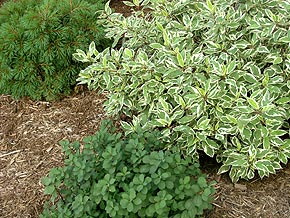 |
| Iris pseudocorus and Euonymus fortunei ‘Canadale Gold’ | Clockwise from upper left: Pinus strobus ‘Blue Shag’ (dwarf white pine); Cornus alba ‘Bailhalo’ (ivory halo dogwood); Spiraea betulifolia ‘Tor’ |
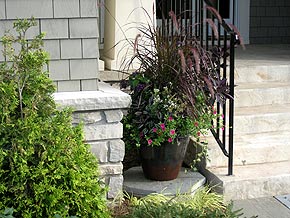 |
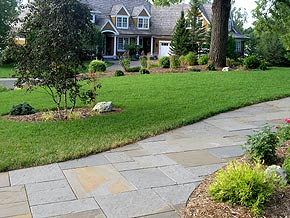 |
| I chose this container and did the arrangement to fill this neat nook by the secondary entrance. Note stone container pad. | I gave the far bed along the street edge of the property a looser, more native look, so that visitors transition smoothly from street and property perimeter to the more colorful and commanding house foundation landscape. |
In just a year the landscape will fill in to a higher density. With width pruning of shrubs, the landscape should look gorgeous for decades to come.
What I most enjoy is that the sidewalk will unquestionably be walked upon (and admired) one hundred years from now, long after I am gone …
PLANT LIST
Trees & Shrubs
- 3 Picea pungens ‘Globosa’ (dwarf blue globe spruce)
- 3 Picea abies ‘Nidiformis’ (bird’s nest spruce)
- 2 Thuja occidentalis ‘Yellow Ribbon’ (arborvitae)
- 5 Chamaecyparis pisifera ‘King’s Gold’ (chamaecyparis)
- 3 Chamaecyparis thyoides ‘Heather Bun’ (chamaecyparis)
- 7 Juniperus squamata ‘Blue Star’ (juniper)
- 5 Juniperus horizontalis ‘Blue Prince’ (juniper)
- 1 Juniperus virginiana ‘Blue Arrow’ (juniper)
- 5 Juniperus chinensis ‘Gold Lace’ (juniper)
- 1 Malus ‘Thunderchild’ (crabapple’
- 1 Betula szechuanica ‘Royal Frost’ (clump birch)
- 2 Magnolia x ‘Ann’ (magnolia)
- 1 Pinus mugo ‘Slowmound’ (mugho pine)
- 1 Pinus mugo ‘Teeny’ (mugho pine)
- 1 Pinus cembra ‘Slim Jim’ (dwarf Scotch pine)
- 2 Taxus cuspidata ‘Monloo’ (emerald spreader yew)
- 6 Rosa ‘Carefree Wonder’ (shrub rose)
- 6 Rosa ‘Blanc Double de Coubert’ (rugosa shrub rose)
- 1 Rosa ‘Macy’s Pride’ (shrub rose)
- 1 Berberis thunbergii ‘Crimson Pygmy’ (barberry)
- 3 Berberis thunbergii ‘Helmond Pillar’ (barberry)
- 1 Berberis thunbergii ‘Bagatelle’ (barberry)
- 4 Buxus ‘ Wilson’ (northern charm boxwood
- 5 Diervilla lonicera (dwarf bush honeysuckle)
- 1 Clethra alnifolia ‘Ruby Spice’ (clethra)
- 2 Cornus alba ‘Bailhalo’ (ivory halo dogwood)
- 5 Euonymus fortunei ‘Canadale Gold’
- 2 Euonymus alatus ‘Compactus’ (dwarf burning bush)
- 1 Fothergilla major ‘Mount Airy’
- 5 Lonicera x xylosteum ‘Emerald Mound’ (honeysuckle)
- 1 Syringa x prestoniae ‘Donald Wyman’ (lilac)
- 5 Physocarpus opulifolius ‘Dart’s Gold’ (ninebark)
- 3 Physocarpus opulifolius ‘Monlo’ (ninebark)
- 4 Amelanchier alnifolia ‘Regent’ (serviceberry)
- 7 Spiraea betulifolia ‘Tor’ (spirea)
- 3 Stephanandra incisa ‘Crispa’ (stephanandra)
- 3 Viburnum dentatum ‘Blue Muffin’ (viburnum)
- 6 Weigela florida ‘Alexandra’ (wine and roses weigela)
Perennials
- Alchemilla mollis ‘Thriller’
- Allium senescens glaucum
- Iris pseudocorus
- Calamagrostis acutiflora ‘Avalanche’
- Hakonechloa macra ‘Aureola’
- Helictotrichon sapphire
- Miscanthus sinensis ‘Rotsilber’
- Heucherella ‘Stoplight’
- Perovskia ‘Little Spire’
- Rudbeckia ‘Goldsturm’
Don Engebretson
The Renegade Gardener